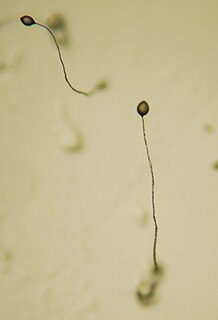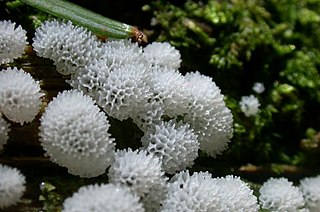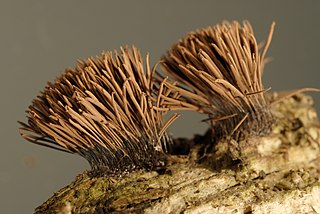
Slime mold or slime mould is an informal name given to several kinds of unrelated eukaryotic organisms with a life cycle that includes a free-living single-celled stage and the formation of spores. Spores are often produced in macroscopic multicellular or multinucleate fruiting bodies which may be formed through aggregation or fusion. Slime molds were formerly classified as fungi but are no longer considered part of that kingdom. Although not forming a single monophyletic clade, they are grouped within the paraphyletic group, Protista.

In biology, a spore is a unit of sexual or asexual reproduction that may be adapted for dispersal and for survival, often for extended periods of time, in unfavourable conditions. Spores form part of the life cycles of many plants, algae, fungi and protozoa.

Dictyostelium is a genus of single- and multi-celled eukaryotic, phagotrophic bacterivores. Though they are Protista and in no way fungal, they traditionally are known as "slime molds". They are present in most terrestrial ecosystems as a normal and often abundant component of the soil microflora, and play an important role in the maintenance of balanced bacterial populations in soils.

The family Acrasidae is a family of slime molds which belongs to the excavate group Percolozoa. The name element acrasio- comes from the Greek akrasia, meaning "acting against one's judgement". This group consists of cellular slime molds.

Lycogala epidendrum, commonly known as wolf's milk or groening's slime, is a cosmopolitan species of myxogastrid amoeba which is often mistaken for a fungus. The aethalia, or fruiting bodies, occur either scattered or in groups on damp rotten wood, especially on large logs, from June to November. These aethalia are small, pink to brown cushion-like blobs. They may ooze a pink "paste" if the outer wall is broken before maturity. When mature, the colour tends to become more brownish. When not fruiting, single celled individuals move about as very small, red amoeba-like organisms called plasmodia, masses of protoplasm that engulf bacteria, as well as fungal and plant spores, protozoa, and particles of non-living organic matter through phagocytosis.

Dictyostelium discoideum is a species of soil-dwelling amoeba belonging to the phylum Amoebozoa, infraphylum Mycetozoa. Commonly referred to as slime mold, D. discoideum is a eukaryote that transitions from a collection of unicellular amoebae into a multicellular slug and then into a fruiting body within its lifetime. Its unique asexual lifecycle consists of four stages: vegetative, aggregation, migration, and culmination. The lifecycle of D. discoideum is relatively short, which allows for timely viewing of all stages. The cells involved in the lifecycle undergo movement, chemical signaling, and development, which are applicable to human cancer research. The simplicity of its lifecycle makes D. discoideum a valuable model organism to study genetic, cellular, and biochemical processes in other organisms.

Fuligo septica is a species of slime mold, and a member of the class Myxomycetes. It is commonly known as scrambled egg slime, or flowers of tan because of its peculiar yellowish, bile-colored appearance. It is also known as dog vomit slime mold, and is relatively common with a worldwide distribution, often being found on bark mulch in urban areas after heavy rain or excessive watering. Their spores are produced on or in aerial sporangia and are spread by wind.

Protosteliomycetes/Protosteliales (ICBN) or Protostelea/Protostelia/Protosteliida (ICZN) is a grouping of slime molds from the phylum Mycetozoa. The name can vary depending upon the taxon used. Other names include Protostelea, Protostelia, and Protostelida. When not implying a specific level of classification, the term protostelid or protosteloid amoeba is sometimes used.

Myxogastria/Myxogastrea or Myxomycetes (ICN), is a class of slime molds that contains 5 orders, 14 families, 62 genera, and 888 species. They are colloquially known as the plasmodial or acellular slime moulds.

A plasmodium is a living structure of cytoplasm that contains many nuclei, rather than being divided into individual cells each with a single nucleus.

Trichiales is an order of slime moulds in the phylum Amoebozoa. Trichiales is one of five orders in the group Myxomycetes, or the true plasmodial slime molds. It is also currently categorized under the superorder Lucisporidia with its sister group, Liceales. The order was first described by Thomas MacBride in 1922, and has retained the same name and status as a defined order in present phylogeny. In the plasmodium form, members of Trichiales lack a columella but have a well-developed capillitium for spore dispersal. The shape and details of the capillitium are used to define families within the order. Spores are brightly coloured, ranging from clear, white and yellow to pink and red-brown tones. The order currently has 4 families, 14 genera and 174 species. Recent molecular research has shown that while Trichiales probably represents a true taxonomic group, its sister group Liceales is likely paraphyletic, and it has been suggested that several genera from the Liceales should be reclassified under Trichiales instead.
Fonticula is a genus of cellular slime mold which forms a fruiting body in a volcano shape. As long ago as 1979 it has been known to not have a close relationship with either the Dictyosteliida or the Acrasidae, the two well-established groups of cellular slime molds. In 1979, Fonticula was made a new genus of its own due to the unique characteristics of its fruiting body, with only one species: Fonticula alba.

In true slime molds (myxogastria), lichens, and in species of the family Clavicipitaceae, the hypothallus is the layer on which the fruit body sits, lying in contact with the substrate. The word is derived from the Ancient Greek root hypó ("under") and thallós.

A plasmodiocarp is a special form of fruit bodies of slime moulds. It is produced if the plasmodium concentrates during the fructification and pull back into the venetion of the plasmodium, from which the fruit body is created. The fruit body traces the process of the venetion, whereby the structure of its subsurface becomes plainly strand-shaped, branched, net or ring-shaped. The production of plasmodiocarps can be generic, or can be also caused by the deranged development of sporocarps or aethalia.

Stemonitis axifera is a species of slime mold. It fruits in clusters on dead wood, and has distinctive tall reddish-brown sporangia, supported on slender stalks.

Hemitrichia is a genus of slime molds, of the family Trichiidae, found within the order Trichiida. It was first described by Josef Rostafinksi in 1873 and remains a well-defined genus of the slime molds. Hemitrichia species exhibit either plasmodiocarp or sporangium fruiting bodies, both of which are well-known and recognizable slime molds seen on multiple continents. The genus includes Hemtrichia serpula, known as the pretzel slime mold, an iconic and widespread species that has been used to examine speciation in slime molds.

Tubifera ferruginosa, more commonly known as raspberry slime mold or red raspberry slime mold, is a species of slime mold in the class Myxogastria. It is one of the most widely known and distinct slime molds, being found throughout temperate regions of the world, primarily in Europe and North America.

Elaeomyxa is a genus of slime molds in the family Lamprodermataceae. As of May 2022, there are four known species in the genus. Species in this genus have been documented in North America, Eurasia, Africa, and Australasia.













